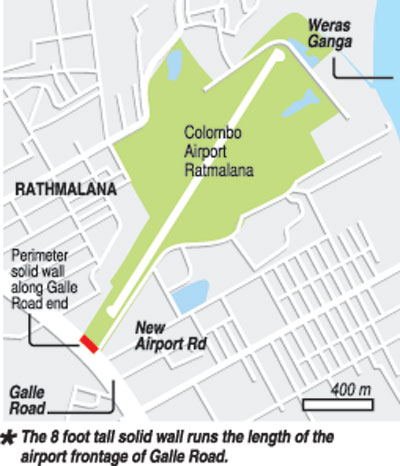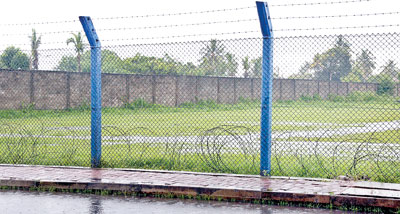News
Safety hazard check for Ratmalana airport border wall
Sri Lanka’s aviation regulator will review the safety of the perimeter wall bordering the Galle Road at Colombo Airport in Ratmalana because of safety concerns expressed by pilots and others. Rohan Manukulasooriya, the regulator’s deputy director general (airspace and security regulation), said a committee will be named this month. The terms of reference are being drafted.
 For several years, some aviators have voiced concerns that the wall is a safety hazard for flights in and out of Ratmalana. They claim the structure will be a significant safety hazard if an aircraft overshoots the runway and crashes into the wall, causing death or injury to passengers and crew.
For several years, some aviators have voiced concerns that the wall is a safety hazard for flights in and out of Ratmalana. They claim the structure will be a significant safety hazard if an aircraft overshoots the runway and crashes into the wall, causing death or injury to passengers and crew.
The solid wall contravenes International Civil Aviation Organization recommendations contained in the ‘Runway End Safety Area’ guidelines that call for “frangible fencing”. A material is said to be frangible if through deformation it tends to break up into fragments, rather than deforming elastically and retaining its cohesion as a single object.
The Colombo Airport management plans to seek aerodrome certification from CAASL to expand their operations and fly larger commercial and cargo aircraft later this year, the Sunday Times learns. The aircraft that will land there in the event of such operational expansion will require the safety measures already in place to be revisited.
The perimeter wall was built during the war against terrorism as a security measure and is an uncommon sight in Sri Lanka. All airports in
Sri Lanka have fencing at the end of each runway in accordance with ICAO guidelines. The perimeter of the Bandaranaike International Airport is also fenced, not walled.
The safety assessment comes in the wake a meeting on domestic aviation held earlier this year at the Prime Minister’s office. The concerns voiced by a group of aviators relate to a “hypothetical situation”, he said, maintaining that the airport complies with regulations. There is a safety area of 240 metres between the end of the runway and the wall, he said.
And the aircraft which use Ratmalana are of a category that does not require use of the full length of runway to take off. Therefore, there was adequate room to land safely in the event of an aborted takeoff. The management is ready to take down the wall if the regulator advises them to do so, said Aruna Rajapaksha, manager of the Colombo Airport, which recently started to accommodate corporate jets that have different takeoff and landing characteristics than the common training aircraft based there before.
The wall does present a safety hazard, said a qualified flying instructor of a leading flying training school at Ratmalana. He did not wish to be named.
“If during landing there is a failure in the landing gear or breaks of the wheels, or there is a sudden gust of wind, the height of the wall presents a problem,” he insisted. “It is an obstacle to novice pilots training at Ratmalana can do without.”
 Although such barriers are not unprecedented in the world, the fact that novice pilots use this runway makes it a matter of legitimate concern and we acknowledge and accept that this is not the ideal set of circumstances,” said Air Vice Marshal Sudarshana Pathirana, director of Air Operations of the Sri Lanka Air Force (SLAF).
Although such barriers are not unprecedented in the world, the fact that novice pilots use this runway makes it a matter of legitimate concern and we acknowledge and accept that this is not the ideal set of circumstances,” said Air Vice Marshal Sudarshana Pathirana, director of Air Operations of the Sri Lanka Air Force (SLAF).
The SLAF had no objections to demolishing the wall, he said, adding that they have “already expressed our agreement although we do believe that it has to be done with due care given to ensuring that the removal does not expose the runway and associated infrastructure to any security threat.”
The CAASL was responsible for not only the safety of aircrew and passenger but also for public safety, Mr Manukulasooriya pointed out. In the event of an accident, the aircraft colliding with the wall could possibly prevent it from running on to the Galle Road. This sentiment was echoed by the H M C Nimalsiri, CAASL director general.
He said there were many airports in India that had solid perimeter walls for security reasons. On August 6, 2018, a Cessna Caravan aircraft operated by Supreme Airlines from Jaipur to Sri Ganganagar in India overshot the runway at Lalgarh and crashed into the solid perimeter wall. There were no reported injuries among the seven passengers and two pilots.


